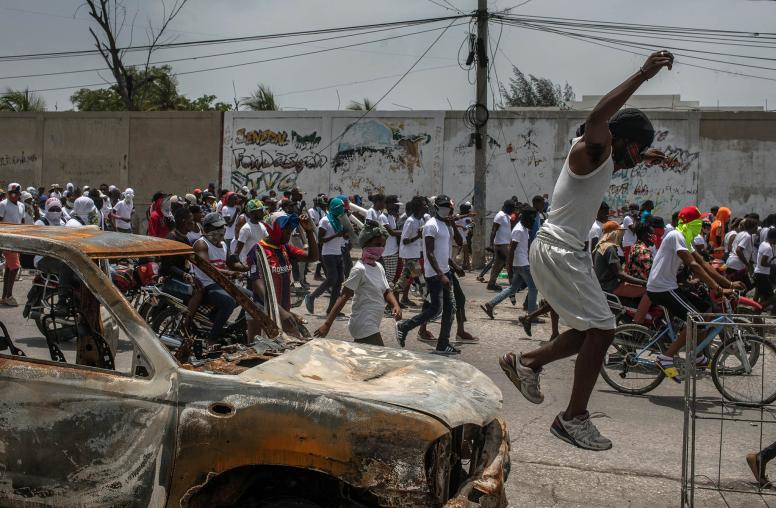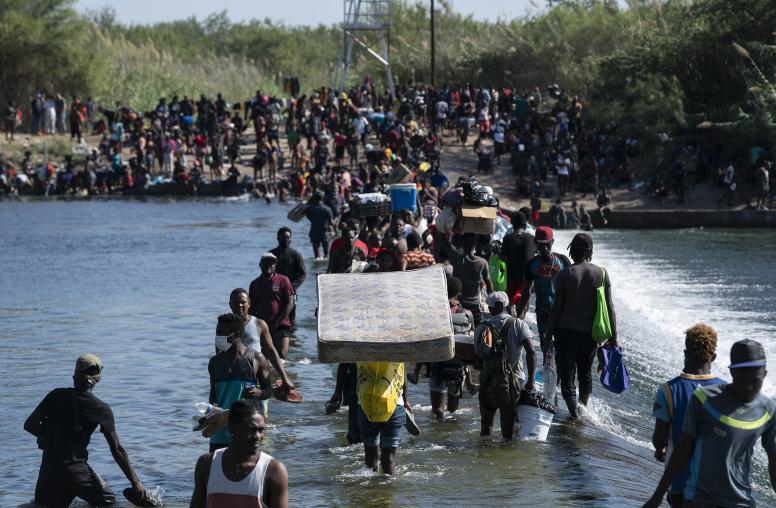Wanted: A Reset of Haiti Policy
As February 7 deadline for interim prime minister’s exit approaches, Haiti faces a deepening political crisis.
Haiti’s governance vacuum triggered by President Jovenel Moïse’s assassination in July 2021 shows few encouraging signs. Violence, notably around Port-au-Prince, has not only grown in lethality, but politically has become the central issue shaping domestic and international discussions. The imminent expiration of acting Prime Minister Ariel Henry’s term in office on February 7 means Haiti’s political crisis is on course to become more intransigent.

To suggest that the country is at a breaking point understates the gravity of the situation — in fact, the months of dithering among key Haitian stakeholders and international partners point to the need for a far more active approach by both Haitian and international actors to the crisis.
Understanding the Problem
For starters, the reference to “gang violence” misjudges the scope, structure and sociology of the problem. The near absence of state-provided security, with as few as an estimated 9,000 Haitian National Police (Police Nationale d’Haïti; PNH) officers for a population of 11.45 million, creates a void where not only gangs flourish but also private security and vigilante justice emerges, further degrading the rule of law. Nor is this phenomenon limited to the capital. While the Port-au-Prince area gets much of the media attention, the rest of Haiti, including farming communities, are at risk of succumbing to the ongoing collapse of law and order.
For now, the capacity of organized gangs (notably G9 and G-Pep) remains limited. Their success in seizing and holding territory is less an indicator of their own institutional cohesion and strategy, and more an indictment of the PNH. However, it is only a matter of time before that changes. The gangs’ ambitions appear to be large, as indicated by their expanding alliances and geography of rampage, and growing, as the collapsing economy energizes the sociopolitical dynamics of gang violence. Moreover, they face little prospect of resistance from the ineffectual interim government led by Henry. The extreme suffering of the Haitian people and the total failure of the government to respond to its citizens’ needs has created distrust and anger among large segments of the Haitian public.
Three Unstable Factors
This toxic mix is now being shaped by three unstable factors:
1) Lack of a viable consensus governance agreement: No viable way forward has emerged from the various attempts to create consensus road maps out of the crisis — these include, most notably, the efforts of the Montana Accord, the 21 December Agreement and the two somewhat overlapping multilateral mediation efforts, the Cari9bbean Community's (CARICOM’s) Eminent Persons Group and the efforts of Inter Mediate led by Jonathan Powell. The failure to achieve consensus is unfortunate and underscores both profound distrust and shortsightedness among key Haitian political actors — and, arguably, disjointed attention to the crisis from Haiti’s key international partners.
Nonetheless, in the aggregate these consensus road maps represent a serious body of proposals, including an articulation of transitional governance instrumentalities and timetables. The problem now is time. Not only is the country in a never-ending, 30-plus month transition, but the Henry-allied December 21 Agreement incorporated an endpoint to the proposed transition process — February 7, also the symbolic date of Haitian presidential transitions. The looming expiration of Henry’s only claim to democratic legitimacy is likely to further deepen Haiti’s political crisis.
2) The Guy Philippe factor: In late November 2023, Guy Philippe, previously jailed in the United States on trafficking charges, returned to Haiti stirring political unrest. Known to observers of Haitian politics for his role in the violent ouster of the second Aristide presidency in 2004, his ill-timed arrival in Haiti raises questions about the bureaucratic synchronization of U.S. policy, and has left many in Haiti perplexed about the motives of U.S. policymakers.
Finding fertile political ground, within several weeks of his arrival Philippe was calling for a national revolution and the ouster of the interim government, and in the process creating panic in civil society. In so doing Philippe joined previous calls originating with Haiti’s gang leaders, and in turn also energized political opportunists — the most visible example being Moïse Jean-Charles, a presidential candidate in 2015 (who came in third) and former mayor of Milot in northern Haiti and member of parliament. Notions of ousting Henry resonate broadly for many Haitians whose daily life is increasingly unbearable, if not deadly. This unholy coalition of disparate actors may agree on Henry’s ouster but lack a follow-on governance consensus — although paradoxically moving toward national elections may be a common, if ill-defined, refrain. This is dangerous.
Community-level disturbances throughout January in Port-au-Prince and across several provincial capitals open up prospects for nationwide violence, as well as the precipitous collapse of what is left of the Haitian state — and no plan “B” except the hoped-for arrival of the international security mission now facing a different mission logistically and politically.
3) A multinational security support (MSS) mission: Such a mission has all along been seen by many in Haiti and beyond as a core element to any resolution of the crisis. Formally requested by Henry at the United Nations in October 2022, the MSS mission belatedly took shape in late summer 2023 and was formalized by a U.N. Security Council vote in October — yet the timetable for the insertion of 1,000 Kenyan police and possibly 1,500 non-Kenyan forces remains fluid. Although a fair amount of behind-the-scenes work has already been achieved in making this operation a reality, fundamental uncertainties remain; some are within Kenyan politics and judicial reviews.
Likewise, the prospects of other countries joining Kenya in significant numbers to make a difference remain ill defined. But the most formidable challenge to the deployment may now be a mutating political scenario in Port-au-Prince, and a broadening uncertainty as to the character of the Haitian governmental partner the MSS mission will be working with.
The next several weeks will be critical. In the ensuing political-security quagmire, the temptation may be strong to explore a workaround of sorts. This would probably entail bypassing the question of the need for an interim Haitian governance consensus (particularly one ensuing from street violence), or out of a sense of panic among Haitian civil society and key political stakeholders and their international partners, cobbling together a fragile governing structure anchored to a calendar (probably 12 months) for national and local elections. Operationally, this would require adjustments in the MSS mission’s scope of engagement but also play to the comfort levels particularly among multilateral organizations’ peacekeeping and election assistance machinery.
Some Plausible Scenarios
But even the above tenuous “workarounds” run the danger of being outflanked by fast-moving events in Haiti. A sample of plausible and not mutually exclusive scenarios might include the following, providing at least some sense of what to avoid and what would help.
Mediation Process 2.0
A political compromise emerges triggered by political pressures, both internal and from the U.S. government, and panic ensuing from recent events, and is shepherded by several high-profile experienced mediators (Haitian and international to include the United States). Such an agreement would need to include the Montana Accord constituency, December 21 Agreement, a cross-section of key political parties (PHTK, OPL, Fanmi Lavalas, En Avant, etc.) and key elements of civil society (private sectors, religious leadership) mostly anchored to an agreement about an electoral calendar and the machinery to make it happen; Mediation Process 2.0 quickly gains support from the U.N. and Organization of American States, including the latter’s electoral assistance capacity. This best-case scenario has been abandoned by some but is still viable.
Muddling Through
A wobbly process that continues on the current course of the United States and other key partners attempting to shore up Haitian security and political capacity for a weakened Henry. It may be anchored by an enlarged (Kenya plus others) international security mission but is jeopardized by the tenuous status of U.S. congressional funding. The uncertainty generated by such an ad hoc approach is likely to degenerate toward more controversial outcomes and brings added risks to the incoming international security force.
The Bukele Model
A consensus emerges to move straight to elections, supported by international technical support and funding, but is ultimately highjacked by populist support for candidates advocating for a security crackdown in the vein of El Salvador’s president, Nayib Bukele. Generic campaign promises about restoring law and order and reenergizing the economy vault a controversial candidate into the presidency. This might generate some sympathetic support from other countries facing violent groups but may also push Haiti into another cycle of heightened violence, as the approach relies on broad suspension of human rights and the Haitian state’s capacity is too weak to effectively execute such a model without significant international assistance.
Full-Scale International Intervention
Whether occurring on a short timetable (Feb. 7, 2024) or at an indeterminate moment later in 2024, the Henry government (or a wobbly successor) is violently overthrown triggering mayhem in major cities. Assuming the MMS mission deployment has occurred, it is quickly overwhelmed by massive waves of population displacements. Regionally, this impacts the Dominican Republic (possibly on the eve of national elections in May) and beyond (including the United States). Reluctantly, the United States rallies a coalition of partners for a security/humanitarian intervention. Belatedly, these events may merge with some of the above scenarios.
Conclusion
In light of the complex challenges facing Haiti, it is imperative that the United States, alongside international partners, adopts a multifaceted approach to support Haiti that is focused on security and governance.
First, the United States should work with international partners to strengthen the MSS mission, ensuring it is equipped to handle the evolving security and political landscape. This would entail a clear road map for deployment, increased technical support for the mission and additional enablers that are missing from the force as envisioned in the areas of intelligence, heavy components and gang diversion.
Second, alongside the security reset, the United States should recognize its unique position as the only actor capable of bringing all Haitian stakeholders to the table and ensuring they remain in the negotiation until a viable governance agreement is reached that paves the way for a stable transition and credible elections. In this capacity, the United States should facilitate a Mediation Process 2.0 to support a Haitian-led solution whose aim is peace and prosperity achieved through democratic means. Any other approach risks a Haiti trapped in a continuing cycle of violence.
Georges Fauriol is a senior advisor with the Latin America program at USIP.

